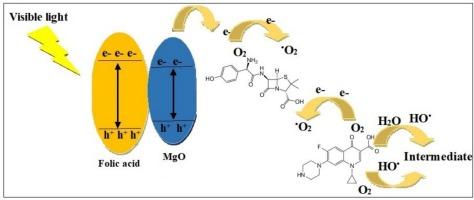Photodegradation of cephalexin and amoxicillin through green-synthesized MgO@folic acid nanoparticles
IF 4.2
Q2 CHEMISTRY, MULTIDISCIPLINARY
引用次数: 0
Abstract
One of the most important aspects of nanotechnology is development of environmentally and non-toxic methods in the production of nanoparticles (NPs). In current study, magnesium oxide nanoparticles (MgO NPs) and MgO NPs combined with folic acid (MgO@F NPs) prepared using Ferula assa-foetida extract. The techniques utilized were Powder X-ray Diffraction (PXRD), Ultraviolet-visible (UV–vis), Dynamic Light Scattering (DLS), Field Emission Scanning Electron Microscope (FESEM), Energy Dispersive X-Ray (EDX), Fourier-Transform Infrared (FT-IR) and zeta potential, which were applied to identify the physicochemical characteristics of MgO and MgO@F NPs. PXRD confirmed the cubic crystal structure of NPs. The EDS finding indicated the presence of main elements of synthesized NPs and their purity. FESEM images showed a spherical and uniform morphology for MgO NPs, which it was changed by adding folic acid to it. The band gaps of 3.5 eV and 2.3 eV were determined using Tauc plots derived from UV–vis absorption data for MgO and MgO@F NPs, respectively. MgO NPs indicated a negative zeta potential, with an average value of −19.8 mV, while zeta potential of MgO@F obtained −8.9 mV. The MgO and MgO@F NPs exhibited degradation efficiencies of 71.92 %, and 80.3 % for CPX and 74.09 % and 84.06 % for AMX, respectively, within 150 min under visible light that follows a first-order reaction model. The separation of charge, the production of reactive oxygen species (ROS), synergistic effects of adsorption and photocatalysis have significantly improved photocatalytic activity. Consequently, the innovative MgO@F NPs exhibits substantial potential for the remediation of wastewater contaminated with pharmaceuticals.

绿色合成MgO@folic纳米酸光降解头孢氨苄和阿莫西林
纳米技术最重要的一个方面是开发环保和无毒的纳米颗粒生产方法。本研究以阿魏提取物为原料制备氧化镁纳米颗粒(MgO NPs)和氧化镁纳米颗粒与叶酸复合(MgO@F NPs)。采用粉末x射线衍射(PXRD)、紫外-可见(UV-vis)、动态光散射(DLS)、场发射扫描电镜(FESEM)、能量色散x射线(EDX)、傅里叶变换红外(FT-IR)和ζ电位等技术对MgO和MgO@F NPs的物理化学特性进行了表征。PXRD证实了NPs的立方晶体结构。能谱分析结果表明合成的NPs主要元素的存在及其纯度。FESEM图像显示,添加叶酸改变了MgO NPs的球形均匀形貌。利用MgO和MgO@F NPs紫外-可见吸收数据得到的Tauc图,分别测定了3.5 eV和2.3 eV的带隙。MgO NPs的zeta电位为负,平均值为- 19.8 mV,而MgO@F的zeta电位为- 8.9 mV。MgO和MgO@F纳米粒子对CPX的降解效率分别为71.92%和80.3%,对AMX的降解效率分别为74.09%和84.06%。电荷的分离、活性氧(ROS)的产生、吸附与光催化的协同作用使光催化活性显著提高。因此,创新的MgO@F NPs在修复被药物污染的废水方面显示出巨大的潜力。
本文章由计算机程序翻译,如有差异,请以英文原文为准。
求助全文
约1分钟内获得全文
求助全文

 求助内容:
求助内容: 应助结果提醒方式:
应助结果提醒方式:


